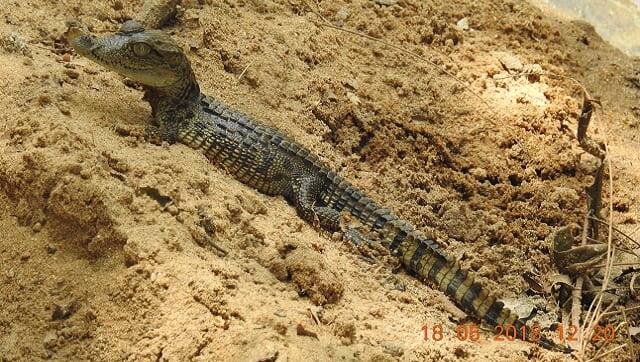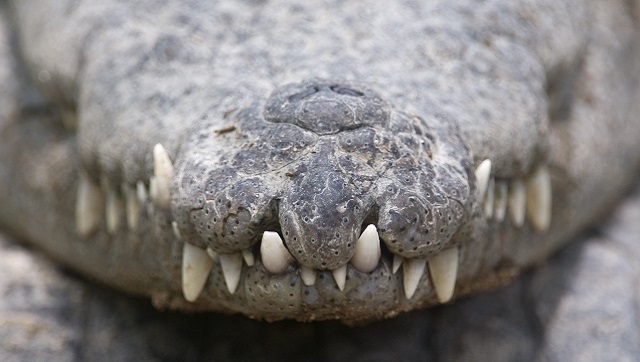I want to think of something besides COVID-19. Sitting on the porch of my cottage, which overlooks Pen 10, I brush away all COVID-19-related thoughts …such as, we need to dredge the pond, a difficult exercise at present because of the cost as well as the logistics of finding and bringing in people to carry out the work. I then look at Pen 10 again, with a different lens (which is a challenge), and focus on the largest mugger or marsh crocodile in the group. Over 10 ft long, his barrel-like body folds into the contours of the bank and as he moves, a black-crowned night heron moves as well… just a tiny bit.
Not, to my human eyes, far enough, but then animals and birds always seem to know what they’re doing, unlike another species which shall not be mentioned.
Somewhere in my old photo albums — mouldy, silverfish-munched black and white memories I don’t have the heart to discard — is a picture of this fellow hatching out of the egg. We watched him hatch, on a stream bank on the Moyar River in the foothills of the Nilgiris. The Moyar is a tributary of the great Bhavani River, and this is where we’d been camping…with our trusty old ragi-pan, coffee pot and a few other essentials that had driven down with us in our old WWII Jonga. The river crossing was memorable, with large submerged boulders that almost overturned the vehicle as one hit the axle with a huge sound-bite. But our most precious possession was the egg-collection permit from the Tamil Nadu Forest Department. With this, we had camped at several crocodile habitats during the nesting season, rescuing the eggs before they were found by local poachers. Prior to Moyar, we had visited Mettur, Sathanur and Amaravathi dams, and sent off several nests back to Madras/Chennai with Irula field assistants who kept the nests cool, damp and stable during the journey by train or bus. [caption id=“attachment_8429411” align=“alignnone” width=“640”]
 Baby mugger/marsh crocodile. Photo courtesy Utkarsha Manish[/caption] At Amaravathi we had to cross a finger of the dam in a coracle, with a box of translocated eggs packed in earth and sawdust. We were seeing off Rajamani at Pollachi, from where he and the eggs would travel back to the Croc Bank. The coracle was of the authentic, buffalo-hide type, not the fibre-glass ones we see today. And as it wasn’t one of the best, it soon started gulping water and spinning round and round like a top. As my side of the boat heaved dangerously once more, my heartless team-mates yelled at me to “Steady the box!” since I was squatting next to it. Obviously there was far more concern for the eggs than for me. But now, sans Rajamani and Dorai — who’d also left with a couple of nests — we were in this magical riverine habitat where forest eagle owls scared the stuffing out of you with their murderous screeches, and you woke up to see panther and bear tracks awkwardly close to the camp. I say camp, but there was no tent or even sleeping bags; we just searched for rocks that were flat enough to sleep on, first come first served. [caption id=“attachment_8429401” align=“alignnone” width=“640”]
Baby mugger/marsh crocodile. Photo courtesy Utkarsha Manish[/caption] At Amaravathi we had to cross a finger of the dam in a coracle, with a box of translocated eggs packed in earth and sawdust. We were seeing off Rajamani at Pollachi, from where he and the eggs would travel back to the Croc Bank. The coracle was of the authentic, buffalo-hide type, not the fibre-glass ones we see today. And as it wasn’t one of the best, it soon started gulping water and spinning round and round like a top. As my side of the boat heaved dangerously once more, my heartless team-mates yelled at me to “Steady the box!” since I was squatting next to it. Obviously there was far more concern for the eggs than for me. But now, sans Rajamani and Dorai — who’d also left with a couple of nests — we were in this magical riverine habitat where forest eagle owls scared the stuffing out of you with their murderous screeches, and you woke up to see panther and bear tracks awkwardly close to the camp. I say camp, but there was no tent or even sleeping bags; we just searched for rocks that were flat enough to sleep on, first come first served. [caption id=“attachment_8429401” align=“alignnone” width=“640”]
 One of the big daddy muggers at the Madras Crocodile Bank. Photo courtesy Umeed Mistry[/caption] It was a treat to watch a nest hatch in the wild; usually, this took place in our lab at the Snake Park and then the Croc Bank. We’d seen the smooth, wet mound of earth as the female rushed off into the water at our approach. We wondered whether she carried water in her mouth, to keep her babies humid and cool? She watched us from the pool, wary but afraid, eyes and nose above water and still as a rock. We moved closer to the nest. And just then, magic happened: we heard the soft nasal Nyuk, Nyuk of hatchling crocs about to hatch. The message is: Let me out of here! This is when the mother croc arrives and scrapes away the earth covering the eggs, freeing the eggs from their mud nest and allowing them to hatch. The small temporary appendage at the tip of the crocodile’s nose, the egg tooth, helps the babies slit the egg shell, and emerge into the world. We performed this action and transferred the hatchlings into a box for their journey to their new home. But there was another night of camping on the stream before we left, and sleep was even harder thanks to the fear that the mother croc would respond to the loud distress calls of her babies, and clamber over our sleeping bodies to rescue them! So now here he is in front of me today, this scaly barrel who is in his prime, and has fathered several generations of hatchlings. One year, I watched him lurking protectively near a bouquet of tiny hatchlings bobbing in the water, keeping them safe from the other dozen or so animals in the pen. Yes, male crocs make good parents; they have even been seen rolling eggs in their mouth, to help them crack open and hatch. How cool is that! Author and conservationist Zai Whitaker is managing trustee — Madras Crocodile Bank Trust/Centre for Herpetology
One of the big daddy muggers at the Madras Crocodile Bank. Photo courtesy Umeed Mistry[/caption] It was a treat to watch a nest hatch in the wild; usually, this took place in our lab at the Snake Park and then the Croc Bank. We’d seen the smooth, wet mound of earth as the female rushed off into the water at our approach. We wondered whether she carried water in her mouth, to keep her babies humid and cool? She watched us from the pool, wary but afraid, eyes and nose above water and still as a rock. We moved closer to the nest. And just then, magic happened: we heard the soft nasal Nyuk, Nyuk of hatchling crocs about to hatch. The message is: Let me out of here! This is when the mother croc arrives and scrapes away the earth covering the eggs, freeing the eggs from their mud nest and allowing them to hatch. The small temporary appendage at the tip of the crocodile’s nose, the egg tooth, helps the babies slit the egg shell, and emerge into the world. We performed this action and transferred the hatchlings into a box for their journey to their new home. But there was another night of camping on the stream before we left, and sleep was even harder thanks to the fear that the mother croc would respond to the loud distress calls of her babies, and clamber over our sleeping bodies to rescue them! So now here he is in front of me today, this scaly barrel who is in his prime, and has fathered several generations of hatchlings. One year, I watched him lurking protectively near a bouquet of tiny hatchlings bobbing in the water, keeping them safe from the other dozen or so animals in the pen. Yes, male crocs make good parents; they have even been seen rolling eggs in their mouth, to help them crack open and hatch. How cool is that! Author and conservationist Zai Whitaker is managing trustee — Madras Crocodile Bank Trust/Centre for Herpetology
)